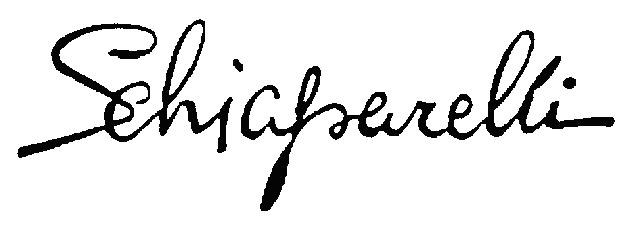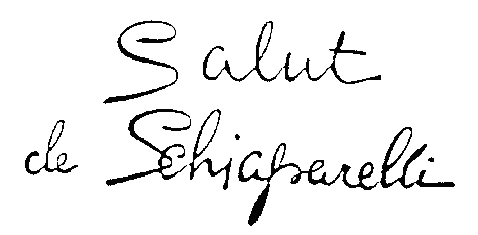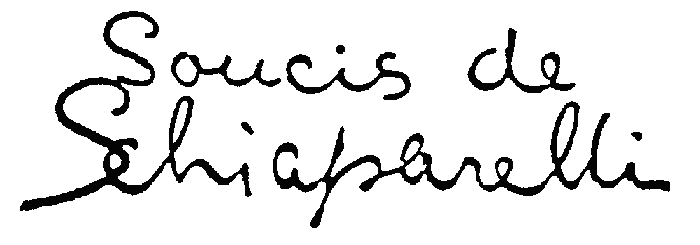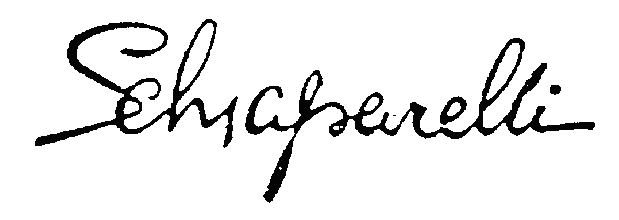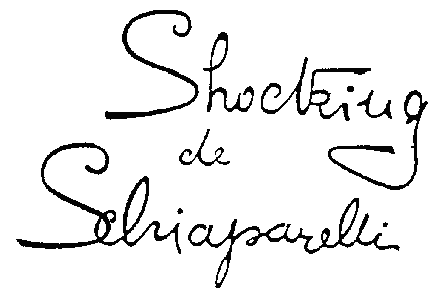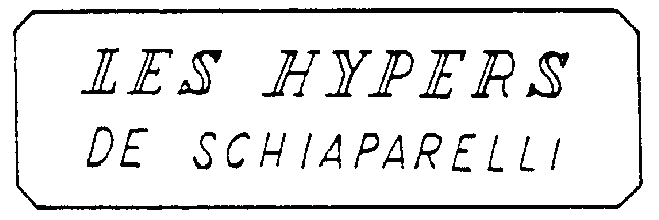Trademark Trial and Appeal Board
Patent and Trademark Office (P.T.O.)
*1 IN RE PARFUMS SCHIAPARELLI, INC.
Serial No. 74/145,226
November 21, 1995
Mary Rossman
Trademark Examining Attorney
Law Office 15
(Paul E. Fahrenkopf, Managing Attorney)
Before Quinn, Hohein and Hairston
Administrative Trademark Judges
Opinion by Hohein
Administrative Trademark Judge
An application has been filed by Parfums Schiaparelli, Inc. to register the mark "SCHIAPARELLI" for "fragrances, namely, perfumes, colognes and toilet waters". [FN1] During initial examination of the application, the Examining Attorney originally in charge thereof entered a statement, by an Examiner's amendment, that "[t]he mark Schiaparelli does not identify a living individual." The Examining Attorney also included a statement that applicant seeks registration of its mark under the provisions of Section 2(f) of the Trademark Act, 15 U.S.C. § 1052(f). Specifically, the application was amended to indicate that applicant "claims acquired distinctiveness" for its mark "as evidenced by ownership of U.S. Registration No. 0820431 on the Principal Register for the same mark for related goods." Such registration, which issued pursuant to Section 2(f), is for the mark "SCHIAPARELLI" for "perfumed hair spray, perfume, toilet water, cologne, bath oils, and dusting powder". [FN2] The registration thus encompasses not only related goods, but also the same goods as those identified in the application.
Inasmuch as the Examining Attorney's search of the records of the Patent and Trademark Office "found no similar registered or pending mark which would bar registration" under Section 2(d) of the Trademark Act, 15 U.S.C. § 1052(d), applicant's mark was published for opposition on March 17, 1992. No opposition having been filed, [FN3] a notice of allowance was issued on October 27, 1992 which allowed applicant six months to file a statement of use or request a six- month extension of time in which to do so. Applicant, on March 10, 1993, requested such an extension, which was approved on April 16, 1993. On October 21, 1993, applicant requested a second six-month extension of time to file its statement of use, noting as good cause therefor that its "negotiations to import the product[s] from France were not successful" and that "arrangements are actively being made to produce the product[s] in the United States." The requested extension was approved on December 18, 1993. Applicant, on January 24, 1994, submitted a statement of use and three specimens of use, claiming dates of first use of December 3, 1993.
Thereafter, the application was reassigned to another Examining Attorney for examination of the statement of use. The Examining Attorney, in an Office action issued on April 30, 1994, noted that while the statement of use was acceptable, "issuance of [a] registration [to applicant] would result in clear error." Specifically, and stating that "this Office action supersedes any previous Office action in connection with this application," the Examining Attorney refused registration under Section 2(d) of the statute on the ground that applicant's mark, when applied to its goods, so resembles the mark "SCHIAPARELLI," which is registered in both the format reproduced below for "women's wearing apparel and accessories--namely, dresses, gowns, scarves, [[[and] vests" [FN4]
*2 and in the manner shown below for "handbags, tote bags, and shopping bags made of fabric and vinyl," [FN5]
as to be likely to cause confusion, mistake or deception. [FN6] The cited registrations are presently owned by the same registrant, Schiaparelli Inc., which like applicant is a New York corporation.
Applicant, in response, conceded that it is not the owner of the cited registrations. However, applicant amended the application to claim ownership of subsisting registrations for the following marks and goods, all of which issued, like the registration forming the basis for its claim of acquired distinctiveness, in the 55-year interval between issuance of the cited registrations: [FN7] (i) "SCHIAPARELLI," which is registered in the stylized form illustrated below for "perfumes"; [FN8]

(ii) "SCHIAPARELLI," which is registered in the script format reproduced below for "soaps"; [FN9]
(iii) "SALUT DE SCHIAPARELLI," which is registered in the cursive style depicted below for "perfumes, toilet waters, and face and talcum powders"; [FN10]
(iv) "SCHIAP," which is registered in the stylized manner shown below for "perfumes, toilet waters and face and talcum powders"; [FN11]
(v) "SOUCIS DE SCHIAPARELLI," which is registered in the script format illustrated below for "perfumes, toilet waters and face and talcum powders"; [FN12]
(vi) "SCHIAPARELLI," which is registered in the cursive form reproduced below for "perfumes, lipsticks, rouges, face creams, toilet waters, and face and talcum powders"; [FN13]
(vii) "SHOCKING DE SCHIAPARELLI," which is registered in the stylized format depicted below for "perfumes, lipsticks, rouges, face creams, toilet waters and face and talcum powders"; [FN14]
(viii) "SLEEPING DE SCHIAPARELLI," which is registered in the stylized manner shown below for "perfumes, toilet waters, rouges, lipsticks, face creams and face and talcum powders"; [FN15]
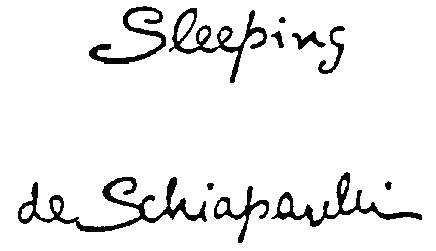
(ix) "SPANKING DE SCHIAPARELLI," which is registered in the script format illustrated below for "perfumes and toilet waters"; [FN16]
and (x) "SHOCKING DE SCHIAPARELLI POUDRE POUF," which is registered for "face powder". [FN17]
Applicant, in light of the longstanding presence on the register of its numerous registrations, insisted in its response that:
While the broad principle that there is a close relationship between fashion clothing and fashion cosmetics is recognized, it is thought that it can hardly be properly applied to the present situation. Clearly not only the cited registrant and its marks and the applicant and its marks have co-existed [sic] for decades in their respective fields, but the parties' respective registrations have co-existed [sic] for years on the Register in the Patent and Trademark Office. It is respectfully submitted that there is no justification for saying at this late date that applicant cannot register its mark SCHIAPARELLI for its goods. The purpose of the present application is to replace several registrations which were not renewed because of a hiatus in use while the product line was being revamped. It is believed that this circumstance hardly causes there to be a likelihood of confusion now when for decades there has been none.
*3 In view of the above, it is submitted that not only was there no clear error in the original approval, but such approval was perfectly proper and consistent. Moreover, no opposition was filed.....
Applicant consequently urged that confusion was not likely.
The Examining Attorney, however, "maintained and continued" the refusal. In addition, "because it appears that there may be or may have been some relationship between the applicant and the owner of the cited registrations," the Examining Attorney interposed a requirement, pursuant to Trademark Rule 2.61(b), that applicant answer a series of questions relating thereto. [FN18]
In view of the Examining Attorney's adherence to the refusal to register, applicant timely filed this appeal. [FN19] Briefs have been filed, but an oral hearing was not requested. We reverse the refusal to register. [FN20]
Both applicant and the Examining Attorney are in agreement that, at this stage in the prosecution of the application, the propriety of the refusal under Section 2(d) is governed by the standard of "clear error". [FN21] Assuming, without deciding, that such is the proper test, [FN22] TMEP § 1105.05(f)(ii), entitled "The 'Clear-Error' Standard in Examination of the Statement of Use," provides in relevant part that:
For the purpose of examination of the statement of use, the Office will issue requirements or refusals concerning matters specifically related to the statement of use only. The Office will not issue any requirements or refusals concerning matters which could or should have been raised during initial examination, unless the failure to do so in initial examination constitutes a clear error. "Clear error" refers to an error which, if not corrected, would result in issuance of a registration in violation of the Act. Cf. Century 21 Real Estate Corp. v. Century Life of America, 10 USPQ2d 2034 (TTAB 1989); Granny's Submarine Sandwiches, Inc. v. Granny's Kitchen, Inc., 199 USPQ 564 (TTAB 1978).
....
Generally, the Office will not conduct any search for conflicting marks, or issue any refusals on that basis, in the examination of the statement of use. However, if the examining attorney determines that a second search is necessary, due to an amendment of the mark or an amendment of the goods or services, the examining attorney will conduct a second search and take action, as appropriate. Likewise, the Office may discover a clear error under Trademark Act § 2(d), 15 U.S.C. § 1052(d), in the course of internal Office quality review or through a letter of protest. The Office will not issue any refusal under § 2(d) in the examination of the statement of use unless the failure to do so constitutes a clear error. For the purposes of § 2(d), the conflict between the application and registration at issue must be such that reasonable minds could not differ as to the necessity for the refusal--that is, failure to issue the refusal would result in issuance of a registration in violation of the Act.
*4 Applicant, asserting that the earliest of its subsisting registrations (Reg. No. 320,501), like the earliest of the cited registrations (Reg. No. 307,089), issued to a common predecessor, Schiaparelli S.A., [FN23] and observing that all of the registrations subsequently issued to applicant not only registered over the earliest of the cited registrations but predate the latest of the cited registrations, contends that (emphasis by applicant):
As is obvious from examination of the registrations, the genesis of the SCHIAPARELLI marks was one Elsa Schiaparelli. As is also evident, the rights to use the mark in the separate fields of clothing and beauty care products were divided with the cited registrant, Schiaparelli, Inc., having the rights for Class 25 goods and applicant having the rights for the Class 3 goods. In the late 1980's the cited registrant expanded its use to Class 18 goods. Applicant did not oppose the ... application[ ] of Schiaparelli, Inc. which resulted in the ... cited Class 18 registration[ ]. Perhaps even more important, the cited registrant did not oppose the present application which was published after approval by the first Examining Attorney.
It is respectfully submitted that the pattern established over 60 years ago clearly indicates that there has been no conflict between the use of the same mark by the two parties involved here and that the separate rights of the two parties in their separate fields has been recognized not only by the parties themselves but by the Patent & Trademark Office. Under these circumstances, the statement by the Examining Attorney that issuance of a registration of the same mark to the same party, applicant, for essentially the same goods as those on which it has registered the mark for over 60 years would constitute "clear error" is absolutely incorrect and untenable. Yet clear error appears to be the only basis on which the Examining Attorney could supersede the prior actions which had reached the point of a Notice of Allowance being issued and a Statement of Use being filed and accepted.
The Examining Attorney states in the second Office Action that the Patent & Trademark Office "cannot speak to all the marketplace realities or actual use known by the cited registrant and this applicant ...". That may well be true, but the Patent & Trademark Office can and should recognize the realities of its own records and the actions of the parties involved in not opposing or in any other way stopping the use and registration of one another's trademarks. There has been no opposition or cancellation and, most important, the cited registrant could have and did not oppose the present application.
Applicant maintains that in light of the above circumstances, "the original approval of the application was entirely correct and surely was not clear error."
The Examining Attorney, on the other hand, insists that confusion is likely. In support of her position, the Examining Attorney has made of record the following evidence to establish that the respective goods are closely related in the mind of the purchasing public, a point which applicant readily concedes: (i) 10 use-based third-party registrations which, in each instance, show a mark which is registered for both fragrance products and clothing; (ii) several advertisements from retail catalogs and fashion magazines which feature, in each case, fragrance products and clothing displayed side-by-side; (iii) other advertisements for fragrance products which, according to the Examining Attorney, "demonstrate that [tote bags are] among the most frequent 'gift with purchase' or 'purchase with purchase' promotions for perfumes and cosmetics"; (iv) excerpts from the 1995 Fashion & Fragrance Desk Diary listing biographical sketches of a number of fashion designers and describing the use of their names on such goods as clothes, fragrances and handbags; (v) advertisements and editorial text from the October 1994 issue of Elle magazine which lists various designer names used in connection with both clothing and fragrances; and (vi) excerpts from The Encyclopedia of Fashion (1986) which detail Elsa Schiaparelli's work in the fashion and fragrance industries. The latter publication, in particular, indicates at 222-23 and 254 that Elsa Schiaparelli, who lived from 1890 to 1973 and held her last show in 1954, was a relatively famous designer of clothing and accessories who was especially well known for her eccentric hats and her "Shocking" brand of perfume. Born in Rome, Italy, she spent her early married life in Boston and New York before moving to Paris, France in 1920. She opened her own salon in Paris in 1929 and, although opening a branch thereof in New York in 1949, exercised her greatest influence on fashion during the 1930s.
*5 According to the Examining Attorney, there is no evidence of a 60-year pattern of contemporaneous use of the "SCHIAPARELLI" mark by applicant and the cited registrant. Instead, the Examining Attorney asserts, the record shows that there was a period of nonuse of such mark by applicant with respect to perfumes, colognes and toilet waters which began, at the very least, sometime shortly before the March 7, 1991 filing date of the present application and ended, as set forth in the statement of use, on December 3, 1993. In view thereof, and given the close relationship between the respective goods at issue; the common practice of fashion designers to use their names as marks for clothing, fragrances and accessories for apparel; the assertedly "unusual" or rare nature of the "Schiaparelli" surname; and the fame of Elsa Schiaparelli in the fashion and fragrance fields, the Examining Attorney contends that the refusal under Section 2(d) is clearly proper in such circumstances because:
The applicant has not provided any authority for determining that a mark is registrable solely because of concurrent registrations or a lack of opposition, particularly, where as here, there are admitted years of non-use [ [ [sic] of the mark sought to be registered; where confusion in analogous situations (identical designer name marks on concededly related fashion items) would be very likely; and where there is no evidence of consent, agreement or understanding.
Applicant, in reply, insists that clear error has not been shown, arguing that (emphasis by applicant):
The point is that the standard which the Examining Attorney is required to meet in order to justify the belated refusal of registration under Section 2(d), i.e., a refusal made while considering the statement of use, is that the conflict between the application and registrations is such that "reasonable minds could not differ as to the necessity for the refusal". This has not been addressed at all.....
[T]he true issue in this case is whether in light of the history of applicant and the cited registrant with the over sixty years contemporaneous use of the mark SCHIAPARELLI in various forms on their respective goods, the conflict between applicant's mark and the registrations is such that reasonable minds cannot differ as to the necessity of the refusal. It is thought that reasonable minds surely can differ on this issue--indeed, the original Examining Attorney and the present Examining Attorney have already differed upon it. And the applicant and cited registrant certainly differ with the present Examining Attorney since they have not opposed one another's applications over the years. There clearly has been no amendment to the mark or the goods which justified a second search, and nothing else has been introduced which represents such a change in the situation as required a second search and the refusal to register.
Among other things, applicant further observes that (footnote omitted): [FN24]
*6 Putting the foregoing aside, there remains the question of whether the name SCHIAPARELLI remains a famous one at this date, some forty years after the last show by Elsa Schiaparelli, and whether that even matters. There is no evidence as to whether it has or has not remained a famous name to the public at large. The purpose of the foregoing argument is not to say that fragrance products and clothing and accessories cannot be related products; they certainly can be, depending upon the fame of the mark involved, and the Board's decisions reflect this. The problem with the Examining Attorney's position is that she has not established that the mark SCHIAPARELLI is a famous one, and if her evidence establishes such fame, the same evidence submitted by applicant of its registrations establishes fame for its mark as applied to its goods. Moreover, the concurrent use and registration by both parties of their marks for their respective goods and their failure to oppose one another's applications show that despite the possible relationship between their goods, they, at least, do not find there to be any likelihood of confusion.
Accordingly, applicant maintains that notwithstanding the evidence furnished by the Examining Attorney, "[t]here is no basis for transforming the evidence ... into a showing of strong likelihood of confusion where the marks of applicant and the cited registrant have been on the record in the Patent [and Trademark] Office for over sixty years."
We concur with applicant that, applying the "clear-error" standard to the issue of likelihood of confusion, such test has not been satisfied. In this regard, we note first of all that the standard of "clear error" is an exception which is applicable to a very limited range of circumstances and, thus, must be narrowly construed. For purposes of a refusal under Section 2(d), "clear error" exists only in those situations where, as articulated in TMEP § 1105.05(f)(ii), the asserted conflict between an application and any cited registration is such that "reasonable minds could not differ as to the necessity for the refusal-- that is, failure to issue the refusal would result in issuance of a registration in violation of the Act." Here, the course of conduct manifested by applicant and the cited registrant, as reflected in the state of the register over a period of more than 50 years, plainly indicates that such parties, who are in the best position to know the realities of the marketplace for their respective products and are the ones most likely to be harmed if confusion occurs, have repeatedly shown, by their behavior toward the acquisition and maintenance of their registrations, their belief that contemporaneous use of marks which consist of or contain the surname "SCHIAPARELLI" is not likely to cause confusion.
Secondly, this case is not one which involves use of the same or substantially similar marks for the same or substantially similar goods and/or services. [FN25] While, of course, applicant's "SCHIAPARELLI" mark must be considered identical to the stylized formats of the cited registrant's "SCHIAPARELLI" marks, [FN26] the respective goods--although closely related-- are nevertheless different. Plainly, perfumes, colognes and toilet waters are not substantially similar to either items of clothing or to handbags or tote bags.
*7 Finally, and determinative of this appeal, there is a lengthy history of coexistence between applicant's registrations for its various "SCHIAPARELLI" marks for fragrances and other cosmetics and the cited registrant's registrations for its "SCHIAPARELLI" mark for apparel. In particular, since the apparent bifurcation in the early 1940s of the clothing and toiletries businesses conducted by the common ancestor of applicant and the cited registrant, there has been a period of over 50 years during which applicant, without any apparent objection from the cited registrant, received a series of registrations (most of which are still subsisting) for its "SCHIAPARELLI" marks for perfumes, toilet waters and other cosmetics, including an existing registration (Reg. No. 820,431) which encompasses the same goods and mark for which applicant presently seeks a registration, while the cited registrant, without any opposition by applicant, expanded its use and registration of its "SCHIAPARELLI" mark from clothing to such fashion accessories as handbags and tote bags. Such "live-and-let-live" attitude has continued, with the cited registrant's notably having failed to avail itself of the opportunity to oppose the present application.
Given these unusual circumstances, we think that notwithstanding the legal identity of the respective marks, their common derivation as the surname of a famous fashion designer, and the close relationship between the respective products, reasonable minds could differ as to whether there is a likelihood of confusion. "Clear error" has therefore not been shown. Plainly, in light of the longstanding pattern of coexistence between applicant's registrations for its "SCHIAPARELLI" marks and those by the cited registrant for its "SCHIAPARELLI" marks, a holding of likelihood of confusion at this late juncture is untenable and would thwart the goal, envisioned by the intent-to-use system, of providing reasonable certainty of receiving a registration once an applicant successfully negotiates the opposition period, receives a notice of allowance, and submits an acceptable statement of use.
Decision: The refusal to register is reversed.
T.J. Quinn
G.D. Hohein
P.T. Hairston
Administrative Trademark Judges, Trademark Trial and Appeal Board
FN1. Ser. No. 74/145,226, filed on March 7, 1991, based on a bona fide intention to use the mark in commerce.
FN2. Reg. No. 820,431, issued on December 13, 1966, which sets forth dates of first use of August 25, 1943; first renewal.
FN3. Although a third party, Schiapparelli 1824 S.p.A., timely requested a 30- day extension of time to oppose, no further action was taken.
FN4. Reg. No. 307,089, issued on October 17, 1933, which states that the mark "has been used continuously ... since November 1927" and "has been registered in France [as] No. 278,023[,] dated December 15, 1931." The registration, which is currently in its third renewal, also indicates that: "The trade-mark consists of a facsimile of the word Schiaparelli as it appears in the personal signature of Elsa Schiaparelli, the president of the [registrant]."
FN5. Reg. No. 1,510,128, issued pursuant to Section 2(f) on October 25, 1988, which sets forth dates of first use of April 10, 1987; combined affidavit §§ 8 and 15.
FN6. The Examining Attorney also refused registration in light of Reg. No. 1,505,917, issued on September 27, 1988, which sets forth dates of first use of April 10, 1987 for the mark "LES HYPERS DE SCHIAPARELLI" and design, as depicted below, for "handbags, tote bags, and fabric and vinyl shopping bags".
The registration recites that the English translation of the words "LES HYPERS" is "THE EXTRA SPECIALS". Such registration, however, has now been canceled pursuant to Section 8 of the Trademark Act, 15 U.S.C. § 1058, and consequently is no longer a potential bar under Section 2(d).
FN7. Additionally, applicant claimed ownership of the following registrations, each of which only recently expired for lack of a third renewal: (i) Reg. No. 319,988, issued on December 18, 1934, for a stylized version of the mark "SALUD DE SCHIAPARELLI" for "perfumes"; (ii) Reg. No. 319,989, issued on December 18, 1934, for a stylized presentation of the mark "SCHIAP" for "perfumes"; and (iii) Reg. No. 319,990, issued on December 18, 1934, for a stylized motif of the mark "SOUCIS DE SCHIAPARELLI" for "perfumes".
FN8. Reg. No. 320,501, issued on January 1, 1935, which states that the mark "has been continuously used ... since July 2, 1934" and "has been registered in France [as] No. 287,096, dated May 19, 1933." The registration, which is presently in its third renewal, also indicates that: "The trade-mark consists of a facsimile of the word 'Schiaparelli' as it appears in the personal signature of Elsa Schiaparelli, the managing director of the [registrant]."
FN9. Reg. No. 394,817, issued on April 28, 1942, which states that the mark "has been continuously used ... since July 10, 1937." The registration, which is currently in its second renewal, further states that: "The mark 'Schiaparelli' comprises the autographic surname signature of Elsa Schiaparelli, the president of the corporate [registrant]."
FN10. Reg. No. 395,115, issued on May 12, 1942, which states that the mark "has been continuously used ... since September 10, 1937." The registration, which presently is in its second renewal, additionally recites that: "The mark 'Schiaparelli' comprises the autographic surname signature of Elsa Schiaparelli, the president of the corporate [registrant]."
FN11. Reg. No. 395,116, issued on May 12, 1942, which states that the mark "has been continuously used ... since August 27, 1937"; second renewal.
FN12. Reg. No. 395,117, issued on May 12, 1942, which states that the mark "has been continuously used ... since September 10, 1937." The registration, which currently is in its second renewal, also states that: "The mark 'Schiaparelli' comprises the autographic surname signature of Elsa Schiaparelli, the president of the corporate [registrant]."
FN13. Reg. No. 395,118, issued on May 12, 1942, which states that the mark "has been continuously used ... since July 10, 1937." The registration, which is presently in its second renewal, additionally states that: "The mark 'Schiaparelli' comprises the autographic surname signature of Elsa Schiaparelli, the president of the corporate [registrant]."
FN14. Reg. No. 395,137, issued on May 12, 1942, which states that the mark "has been continuously used ... since July 10, 1937." The registration, which is presently in its second renewal, also indicates that: "The mark 'Schiaparelli' comprises the autographic surname signature of Elsa Schiaparelli, the president of the corporate [registrant]."
FN15. Reg. No. 395,138, issued on May 12, 1942, which states that the mark "has been continuously used ... since March 1, 1940." The registration, which is currently in its second renewal, further states that: "The mark 'Schiaparelli' comprises the autographic surname signature of Elsa Schiaparelli, the president of the corporate [registrant]."
FN16. Reg. No. 396,948, issued on August 11, 1942, which states that the mark "has been continuously used ... since January 19, 1942." The registration, which presently is in its second renewal, additionally recites that: "The mark 'Schiaparelli' comprises the autographic surname signature of Elsa Schiaparelli, the president of the corporate [registrant]."
FN17. Reg. No. 875,325, issued on August 19, 1969, which sets forth dates of first use of September 1967; first renewal. The registration states that: "The translation of the words 'Poudre Pouf' is 'powder puff'."
FN18. In particular, the Examining Attorney referred to "the factors considered in In re Schoeneman Enterprises, Inc., S/N 74/126,146, --- USPQ2d ---- (TTAB 1993)". Such decision, although it still has not been published, was designated for publication and, accordingly, we have considered it as precedent in this case. For a synopsis thereof, see VII Allen's Trademark Digest F-133 (January 10, 1994).
FN19. Trademark Rule 2.141 provides in pertinent part that: "A second refusal on the same ground may be considered as final by the applicant for purpose of appeal."
FN20. In consequence thereof, and since the Examining Attorney's requirement that applicant provide certain information bearing upon the refusal to register basically relates to a suggested approach for possibly overcoming the refusal, the requirement is considered moot.
FN21. We note in particular that, while taking issue with the Examining Attorney's conclusion that clear error occurred in the failure to raise the refusal initially, applicant has voiced no objection to the "clear-error" standard itself, as espoused by the Trademark Examining Organization in TMEP § 1105.05(f)(ii).
FN22. It appears from the legislative history, however, that an even stricter standard was intended. Section 1(d)(1) of the Trademark Act, 15 U.S.C. § 1051(d)(1), specifies in material part that:
Subject to examination and acceptance of the statement of use, the mark shall be registered in the Patent and Trademark Office.... Such examination may include an examination of the factors set forth in subsections (a) through (e) of Section 2.....
As is plain from the legislative history, it was originally envisioned that "examination of the statement of use will only be for the purpose of determining issues that could not have been fully considered during the initial examination of the application, that is, whether the person filing the statement of use is the applicant, whether the mark as used corresponds to the drawing submitted with the application, whether the goods or services were identified in the application and not subsequently deleted, and whether the mark, as displayed in the specimens or facsimiles, functions as a mark." See Senate Judiciary Committee Rep. on S.1883, S.Rep. No. 515, 100th Cong., 2d Sess. 34 (1988), reprinted in United States Trademark Association, The Trademark Law Revision Act of 1988, 186 (1989). That examination of the statement of use could also "include an examination of the factors set forth in subsections (a) through (e) of section 2" was added by H.R.5372, a clean bill introduced on September 23, 1988, but the scope of such provision was intended to be limited to permitting the Patent and Trademark Office "to raise issues of registrability that might not be evident until the applicant makes available specimens showing the mark as used and/or clarifying the nature of the goods or services involved." See House Judiciary Committee Rep. on H.R.5372, H.R.Rep. No. 1028, 100th Cong., 2d Sess. 2, 9 and 19, reprinted in United States Trademark Association, The Trademark Law Revision Act of 1988, 278, 285 and 295 (1989).
In subsequent Senate debate with respect to such addition, it was pointed out that:
[T]he House version provides for a second examination of the intent-to-use application after the applicant submits a statement of use. The Senate did not include this provision because we wanted to assure that once the Patent and Trademark Office [PTO] conditionally approved registration, the applicant would have the needed certainty to invest in actual use of the mark without fear that the PTO might reverse its earlier approval of the mark for registration.
The Senate recognizes that there may be limited situations in which the PTO can consider some registration issues only after use is made. The House bill provides for a second examination to accommodate these rare occasions, and only in these situations will a second examination be allowed. If the issue can be addressed during the first examination, clearly it must be addressed then. The PTO cannot be given the opportunity to reverse its conditional approval of a mark's registrability on the basis of facts that could have been--that should have been--looked at during the first examination.
134 Cong.Rec. S16973 (daily ed. October 20, 1988) (statement of Sen. DeConcini), reprinted in United States Trademark Association, The Trademark Law Revision Act of 1988, 334 (1989). Nevertheless, a compromise version of S.1883, which included the addition of Section 1(d)(1) as passed by the House, was agreed upon and became the Trademark Law Revision Act of 1988 (Public Law 100-667, November 16, 1988).
Consequently, with respect to the proper scope of examination of a statement of use pursuant to Section 1(d)(1), we note the following comment, which is set forth in United States Trademark Association, The Trademark Law Revision Act of 1988, 344 (1989):
Although the Act provides that this examination may include consideration of issues set forth in sections 2(a) through (e) of the Act, legislative history indicates that this examination is intended for purposes of considering issues that could not have been addressed before the notice of allowance was issued and use was initiated. If it were not so limited, the certainty envisioned by the intent-to-use system would not be realized.
FN23. While, as to such factual assertions, the better practice (because it is more persuasive) would have been for applicant to submit an affidavit or declaration from one or more individuals having personal knowledge of the facts recounted instead of applicant counsel's simply stating such facts in a brief, we have nevertheless considered counsel's factual representations since they make no difference in the outcome of this appeal.
FN24. Applicant also insists, although notably without furnishing copies of the documents referred to, that (footnote omitted):
Applicant did not respond to the Examining Attorney's inquiries regarding the relationship between it and the cited registrant because it felt that in light of the merits of the case, this was not necessary. However, to set the record straight, it is noted that there is no written agreement between applicant and the cited registrant. Doubtless, both applicant and the cited registrant had individual agreements with Elsa Schiaparelli relating to their specific products. As the owner of the rights to her name and mark on the various products, Madame Schiaparelli had a right to license and/or sell her rights in her name and mark in different fields to different parties. Unfortunately, the agreements, which may date back to the early 1940's or the 1930's, have not been located.... There is, however, an Amendment to Royalty Agreement of June 28, 1945, which amendment is dated as of April 1, 1958, between Elsa Schiaparelli and Parfums Schiaparelli, Inc. and which clearly sets forth the rights of applicant to use the name and mark "Schiaparelli" and other trademarks on cosmetics, perfumes and toilet articles in the Continental United States, Hawaii and Canada. This is not the agreement that grants the rights; it reflects them in its "whereas" clauses and provisions. It is thought that the dual lines of use from the common ancestor are obvious from the fact that some of the marks registered by applicant and the cited registrant are in the identical form. And it is submitted that the continued honoring by the parties of agreements dating back 50 years should not be wholly ignored because the current trend in the beauty and fashion industries is for successful apparel designers to license their names for a variety of products, including perfume.
FN25. It is also significant that, unlike the situation in Eastman Kodak Co. v. Bell & Howell Document Management Products Co., 994 F.2d 1569, 26 USPQ2d 1912 (Fed.Cir.1993), this case is not one in which an issue of registrability can only be determined once a statement of use has been filed.
FN26. See, e.g., Phillips Petroleum Co. v. C.J. Webb, Inc., 442 F.2d 1376, 170 USPQ 35, 36 (CCPA 1971).




